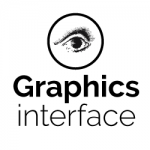The 2020 CHCCS/SCDHM Service Award of the Canadian Human-Computer Communications Society is presented to Dr. Kellogg Booth for his contributions over four decades to the Canadian and international computer graphics, visualization, and human-computer interaction community through his many roles in the organization and its conferences.
Our organization depends on service and commitment from its community. Typical of Dr. Booth, he is quick to point out that his is only the latest in a history of extensive service contributions recognized by this award. Dr. Wayne Davis was the longest-serving President of the organization, leading it through a renaming to the Canadian Human-Computer Communications Society (CHCCS) in 1991 and a renaming of the conference to Graphics Interface (GI) after Dr. Ron Baecker and William (Bill) Buxton organized an off-year conference with that name in 1982. Booth credits Davis and Dr. Fred Peet, who served as Treasurer for the organization for almost three decades, for their tireless work overseeing the organization and the conferences. Davis’s contributions were recognized by the second-ever CHCCS Achievement Award in 1992. Peet’s contributions were recognized by the first-ever CHCCS Service Award in 2005. Subsequent service awards recognized notable CHCCS members for contributions to large-scale community infrastructure (Gary Perlman, 2007 ; James Stewart, 2008), digital media research management (Adrian Sheppard, 2017) and intellectual mentorship (Pierre Poulin, 2019). This is not an award given lightly.
However, few have carried the CHCCS torch with more dedication and perseverance than Kelly Booth. He has been involved with CHCCS from its very early days. He began with what became the annual Graphics Interface (GI) conference in 1981, serving as local arrangements co-chair for the former Canadian Man-Computer Communications Society’s biennial conference and on the program committee. He has continued to serve on the conference’s program committees off and on over the years, as well as serving as general co-chair in 1992 for the first AI/GI/VI triple conference in Vancouver and again in 2005 for the renamed AI/GI/CRV triple conference in Victoria, and as program co-chair for GI in 1998. When he was not on the GI program committee, he often served as a reviewer for the conference. He was elected President of the Canadian Human-Computer Communications Society in 2002 and served six years in that role and another six as Past Chair. As President, his goal was to preserve the founders’ legacy of what had become an internationally recognized annual conference on computer graphics, visualization, and human-computer interaction. The first conference in 1969 was conceived by a group of researchers from academic, government, and industry labs who foresaw the importance of emerging technologies such as computer graphics and the importance of considering the interplay between humans and the interactive computer systems being designed for their use. Conferences were held every second year and the Canadian Man-Computer Communications Society (CMCCS) was formed as a special interest group within the Canadian Information Processing Society (CIPS) to provide sponsorship for the conference.
In addition to his other roles, Booth actively encouraged the annual “triple conference” that brought together GI with the Canadian conference on artificial intelligence and the Canadian conference on computer vision. With Dr. Alain Fournier, Booth served as general co-chair for the first of the triple conference, held in 1992 at the University of British Columbia in Vancouver, six years after a double conference at UBC featuring GI and the computer vision conference. He served on the steering committee for the triple conference for many years, first as one of two official CHCCS representatives and then as an informal advisor. During this time, the triple conference became an annual event, in part due to his enthusiastic support for having a broad-based Canadian venue to showcase the highly cross-disciplinary advances demonstrating synergy between the underlying themes of artificial intelligence, graphics, HCI, vision, and visualization.
He has been very active in the CHCCS awards program. The first award in 1990 was a “one off” to honor Dr. Marceli Wein, another early pioneer whose influence helped shape the uniquely Canadian aspects of the conference, while also growing it into an international venue for top quality research. This was followed two years later by the second award to Wayne Davis and then one award in each of the three years 1994, 1995, and 1996 that established the formal Achievement Award program. After a hiatus of nine years, Achievement Awards became an annual event in 2005. Booth served on the awards committee for three years during this time and later a second five-year term during much of which he chaired the committee. Under his leadership, the CHCCS Service Award was established, and the Alain Fournier and the Bill Buxton Dissertation Awards and the Canadian Digital Media Pioneer Awards were incorporated into the CHCCS awards program. The annual Michael A. J. Sweeney best student conference paper and the best conference poster award programs were also solidified during this time. Each award recognizes a different aspect of accomplishment within the fields of computer graphics, visualization, and human-computer interaction.
Dr. Kellogg S. Booth is Professor Emeritus of Computer Science at the University of British Columbia. He previously held a faculty position in Computer Science at the University of Waterloo and prior to that worked as a computer scientist at Lawrence Livermore National Laboratory while completing two graduate degrees at the University of California, Berkeley. His undergraduate degree from Caltech was in mathematics. He became interested in computing while a student at Palos Verdes High School where he learned programming in a local science club and during a field trip to Systems Development Corporation the importance of what became the field of human-computer interaction when he was told that half the people developing the SAGE software had mathematics degrees and the other half had psychology degrees.





